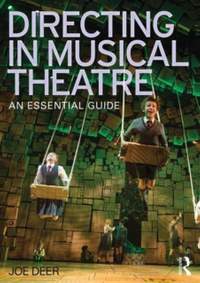Contents
- Table of Contents
- Foreword by Eric Schaeffer
- Introduction
- How To Use This Book
- Phase One: Conception
- Timetable One: Preparation
- Chapter One: Preparing for Collaboration
- Unit 1.1 Reading and listening to the Musical
- Unit 1.1.1 Gathering Impressions
- Questionnaire: First Impressions
- Unit 1.2 Creating a Research Portfolio
- Unit 1.3 History and Society Viewed Selectively
- Unit 1.4 Tradition
- Unit 1.5 Dissecting the Script and Score
- Unit 1.5.1 Units of Action
- Questionnaire: Unit Analysis
- Unit 1.6 Character Analysis
- Unit 1.6.1 Facts
- Questionnaire: Character Given Circumstances
- Unit 1.6.2 Character Journey
- Unit 1.6.3 Charting Change
- Unit 1.6.4 Attitudes
- Questionnaire: Character Attitudes
- Unit 1.6.5 Ambitions
- Questionnaire: Character Ambitions
- Unit 1.7 Directing and Style
- Unit 1.7.1 What Is Style?
- Unit 1.7.2 Establishing Style in Your Production
- Unit 1.7.3 Unity of Style
- Unit 1.7.4 History and Genre
- Unit 1.7.5 Worldview
- Questionnaire: Defining Worldview
- Unit 1.7.5 Articulating Style
- Questionnaire: Elements of Style
- Unit 1.8 Visiting the Performance Space
- Unit 1.9 Getting It Down On Paper - Creating a Concept Statement
- Unit 1.9.1 This Is The Story Of ...
- Unit 1.9.2 Themes and Ideas
- Unit 1.9.3 Images and Visual Style
- Unit 1.9.4 State Your Passion
- Chapter Two: Imagining The Chorus
- Unit 2.1 What is a chorus?
- Unit 2.2 Populating the world of your musical
- Unit 2.3 The power of the group
- Unit 2.4 Applying Pressure
- Unit 2.5 Chorus as Storyteller
- Unit 2.6 Chorus as Spectacle
- Unit 2.7 Chorus as Characters
- Unit 2.8 Engaging Chorus Actors
- Phase Two: Collaboration
- Timetable: Phase Two
- Chapter Three: Creative Collaboration
- Unit 3.1 The Passionate Center
- Unit 3.2 What is a Choreographer?
- Unit 3.3 Theatre Dance vs. Concert Dance
- Unit 3.4 Musical Collaboration
- Chapter Four: Directing the Design
- Unit 4.1 Design Process: Scenery
- Unit 4.1.1 Scenic Design Preparation
- Questionnaire: Scenic Design
- Unit 4.1.2 What to Expect in the Scenic Design Process
- Scenic Design Process for Big River
- Unit 4.2 Design Process: Costumes
- Unit 4.2.1 Character Analysis for Costume Design
- Unit 4.2.2 Practical Requirements
- Unit 4.2.3 Cast by Scene Breakdown
- Unit 4.2.4 What to Expect in the Costume Design Process
- Gregg Barnes' Costume Design Process for The Drowsy Chaperone
- Unit 4.3 Design Process: Lighting
- Unit 4.3.1 What to Expect in the Lighting Design Process
- Natasha Katz' Lighting Design Process for Follies
- Unit 4.4 Budgets and Creative Limits
- Checklist: Effective Design
- Phase Three: Rehearsal
- Timetable Three: Auditions to Final Studio Run-Through
- Chapter Five: Auditions
- Unit 5.1 Casting Breakdowns
- Unit 5.2 Principal Role Auditions
- Unit 5.3 Chorus Calls
- Unit 5.4 Addressing Multiple Casting Needs
- Unit 5.5 Non-Traditional Casting
- Unit 5.6 Negotiations and Waiting
- Chapter Six: Staging and Coaching
- Unit 6.1 Staging Stories
- Unit 6.1.1 Levels of Staging
- Unit 6.1.2 Staging Questions
- Questionnaire: Staging Action
- Unit 6.1.3 Believable Spontaneity and Inevitability
- Unit 6.1.4 Types of Musical Numbers
- Unit 6.1.5 Prompts to Staging Opportunities
- Unit 6.1.6 Staging Structure
- Unit 6.1.7 Storytelling Through Staging
- Unit 6.1.8 All Staging is Action
- Unit 6.1.9 Storytelling - Beat-by-beat
- Unit 6.1.10 Group Staging Notation
- 'I Wanna Be A Producer' from The Producers
- Unit 6.1.11 Choreographic Staging
- Unit 6.2 Staging Tools
- Unit 6.2.1 Movement and Images
- Unit 6.2.2 Principles of Effective Blocking
- Unit 6.2.3 Compositional Qualities
- Unit 6.3 Blocking Scenes and Songs
- Unit 6.3.1 Blocking Script Set Up
- Next to Normal scene/song blocking script
- Unit 6.3.2 Ideas Into Action
- Unit 6.3.3 Blocking Notation
- Unit 6.3.4 Giving Blocking to Actors
- Unit 6.4 Coaching Your Cast
- Unit 6.4.1 Actor/Singers
- Unit 6.4.2 10 Keys to Coaching the Singing Actor
- Unit 6.4.3 Dancers are actors, too
- Unit 6.5 Entertainment Values and 'Selling It' To The Audience
- Phase Four: Production
- Timetable: Phase Four
- Chapter Seven: Moving Into The Theatre
- Unit 7.1 Getting acquainted with the space
- Unit 7.2 Spacing Rehearsals and Adjustments
- Unit 7.3 Safety First
- Unit 7.4 Adding Scenery and Props
- Unit 7.5 Adding Lighting
- Unit 7.6 Adding Orchestra
- Unit 7.7 Sound Design and Reinforcement
- Unit 7.8 The Stage Manager Takes Charge - Technical Rehearsal
- Unit 7.9 Adding Costumes
- Unit 7.10 Crew
- Unit 7.11 Special Rehearsals
- Unit 7.12 Putting It All Back Together
- Unit 7.13 Finding The Heart of the show again
- Unit 7.14 Prioritizing and Problem Solving
- Unit 7.15 "Please" and "Thank You"
- Phase Five: Performance
- Timetable: Previews to Closing
- Chapter Eight: Shaping the Production
- Unit 8.1 Curtain Calls
- Unit 8.2 Previews
- Unit 8.3 Advice and Opinions
- Unit 8.4 Opening Night
- Unit 8.5 Notes and Rehearsal After Opening
- Unit 8.6 Post Mortem
- Chapter Nine: Etcetera - And All The Rest
- Unit 9.1 Directing New Works
- Unit 9.2 Directing Revues
- Unit 9.3 Habits of Successful Directors
- Appendices
- Appendix A: Sample Documents
- Weekly Rehearsal Schedule - Seussical
- Daily Rehearsal Schedule - Carousel
- Blocking/Staging Checklist - Seussical
- Cast-by-scene Breakdowns - Nine
- Scene and Song Rehearsal Unit Breakdown - Kiss Me, Kate
- Concept Statement - Into The Woods
- Scene/Song Unit Analysis - Fiddler On The Roof
- Character Analysis (short) - The Light In The Piazza
- Staging Roadmap (Beat Breakdown) - 'The Night Waltz' from A Little Night Music
- Appendix B: Complete Production Timetable
- Appendix C: Blank Questionnaires
- First Impressions
- Unit Analysis
- Character Given Circumstances
- Character Attitudes
- Character Ambitions
- Defining Worldview
- Elements of Style
- Scenic Design
- Staging Action
- Checklist: Effective Design
- Appendix D: A Brief Glossary of Useful Stage Terms




